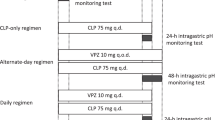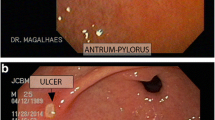Abstract
There is much evidence that a combination of ibuprofen (IBU) and Aspirin (ASA) can antagonize the irreversible inhibition of platelet function. This study was designed to investigate the degree of gastric damage, bleeding time (BT) and fluctuations in the serum levels of prostaglandin E2 (PGE2) and thromboxane A2 (TXA2) after oral administration of ASA (200 mg/kg) and IBU (50 mg/kg) either alone or in combination in rats in vivo. The stomach was assessed for any damage either after 6 h, 18 h or 6 days and carboxymethylcellulose (1% CMC) served as a vehicle and control. ELISA was used to measure TXA2 and PGE2 in serum. Bleeding time was assessed using tail blood. The results show that ASA and IBU either alone or in combination can cause gastric ulceration in 25–100% of the rats at 6 and 18 h. In contrast, gastric ulceration was seen in 50% of rats with a combination of ASA given before IBU only after 6 days of oral administration. BT was unaffected either by ASA or IBU when administered alone except after 18 h for IBU. In contrast, BT was significantly reduced when IBU was administered before ASA after 18 h and 6 days (P < 0.001). Serum PGE2 levels decreased significantly after ASA administered either alone or in combination with IBU for 6 h, 18 h and 6 days (P < 0.05). Serum TXA2 levels were significantly reduced after 6 h, 18 h and 6 days following ASA and IBU administration except for IBU alone which caused a significant increase in serum TXA2 6 days after its administration (P < 0.01). It can be concluded that ASA and IBU administered either alone or in combination can cause gastric ulcers in the rat stomach after 6 h and 18 h, but less severe after 6 days. IBU either alone or in combination with ASA reduced BT only after 18 h and 6 days of administration. Together, the results show that gastric ulceration correlated well with the inhibition of serum PGE2 and TXA2 levels.




Similar content being viewed by others
References
Yuan Y, Padol I, Hunt RH (2006) Peptic ulcer disease today. Nat Clin Pract Gastroenterol Hepatol 3(2):80–89
Scarpignato C, Hunt RH (2010) Nonsteroidal antiinflammatory drug-related injury to the gastrointestinal tract: clinical picture, pathogenesis, and prevention. Gastroenterol Clin N Am 39(3):433–464
Hunt RH (2011) Yuan Y acid-NSAID/aspirin interaction in peptic ulcer disease. Dig Dis 29(5):465–468
Patrono C, Coller B, Dalen JE, FitzGerald GA, Fuster V, Gent M, Hirsh J, Roth G (2001) Platelet-active drugs: the relationship among dose, effectiveness, and side effects. Chest 119:39S–63S
Whittle BJR (1977) Mechanisms underlying gastric mucosal damage induced by indomethacin and bile-salts, and the actions of prostaglandins. Br J Pharmacol 60:455–460
Smith WL (2008) Nutritionally essential fatty acids and biological indispensable cyclooxygenases. Trends Biochem Sci 33(1):27–37
Davi G, Patrono C (2007) Platelet activation and atherothrombosis. N Engl J Med 357(24):2482–2494
Lange R, Hillis L (2004) Antiplatelet Therapy for ischaemic heart disease. N Engl J Med 350:277
Di Minno G, Silver MJ, Murphy S (1983) Monitoring the entry of new platelets into circulation after ingestion of aspirin. Blood 61:1081–1085
Prusakiewicz J, Duggan K, Rouzer C, Marnett L (2009) Differential sensitivity and mechanism of inhibition of COX-2 oxygenation of arachidonic acid and 2-arachidonoylglycerol by ibuprofen and mefenamic acid. Biochemistry 49:7353–7355
FitzGerald GA, Patrono C (2001) The coxibs, selective inhibitors of cyclooxygenase-2. New Engl J Med 345:433–442
Catella-Lawson F, Reilly MP, Kapoor SC, Cucchiara AJ, DeMarco S, Tournier B, Vyas SN, FitzGerald GA (2001) Cyclooxygenase inhibitors and the antiplatelet effects of aspirin. N Eng J Med 345(25):1809–1817
MacDonald TM, Wei L (2003) Effect of ibuprofen on cardioprotective effect of aspirin. Lancet 361(9357):573–574
Rajkapoor B, Anandan R, Jayakar B (2002) Anti-ulcer effect of Nigella sativa Linn. against gastric ulcers in rats. Curr Sci 82(2):177–179
Ligumsky M, Sestieri M, Karmeli F, Zimmerman J, Okon E, Rachmilewitz D (1996) Rectal administration of nonsteroidal antiinflammatory drugs. Gastroenterology 98:1245–1249
Wang YY, Tang ZY, Dong M, Liu XY, Peng SQ (2004) Inhibition of platelet aggregation by polyaspartoyl l-arginine and its mechanism. Acta Pharmacol Sin 25:469–473
Ng SC, Chan FK (2010) NSAID-induced gastrointestinal and cardiovascular injury. Curr Opin Gastroenterol 26(6):611–617
Superceanu B, Veldhuyzen van Zanten S, Skedgel C, Shepherd M, Sketris I (2010) The rate of prescribing gastrointestinal prophylaxis with either a proton pump inhibitor or an H2-receptor antagonist in Nova Scotia seniors starting nonsteroidal anti-inflammatory drug therapy. Can J Gastroenterol 24(8):481–488
Bastaki SMA, Wallace JL (1999) Pathogenesis of nonsteroidal anti-inflammatory drug gastropathy: clues to preventive therapy. Can J Gastroenterol 13(2):123–127
Morris TH (2005) Dose estimation among species. In: Hawk CT, Leary S, Morris T (eds) Formulary for laboratory animals, 3rd edn. Wiley, Ames, pp 3–14
Kirkwood JK (1983) Influence of body size in animals on health and disease. Vet Rec 113(13):287–290
Adelman R, Saul RL, Ames BN (1988) Oxidative damage to DNA: related to species metabolic rate and life span. Proc Natl Acad Sci 85(8):2706–2708
Chandranath SI, Bastaki SMA, Singh J (2002) A Comparative study on the activity of lansoprazole, omeprazole and PD-136,450 on acidified-ethanol- and indomethacin-induced gastric lesions in the rat. Clin Exp Pharmacol Physiol 29:173–180
Yeomans ND, Hawkey CJ, Brailsford W, Naesdal J (2009) Gastroduodenal toxicity of low-dose acetylsalicylic acid: a comparison with non-steroidal anti-inflammatory drugs. Curr Med Res Opin 25(11):2785–2793
Isozaki Y, Yoshida N, Ichikawa H, Kuroda M, Kokura S, Naito Y, Okanoue T, Yoshikawa T (2005) A novel water-soluble vitamin E derivative protects against aspirin-induced gastric mucosal injury in rats. Int J Mol Med 16(6):1035–1040
Jacobson ED (1992) Circulatory mechanisms of gastric mucosal damage and protection. Gastroenterology 102(5):1788–1800
Chaudhury TK, Jacobson ED (1978) Prostaglandin cytoprotection of gastric mucosa. Gastroenterology 74:58–63
Whittle BJR (1983) Potentiation of taurocholate-induced rat gastric erosions following parenteral administration of cyclooxygenase inhibitors. Br J Pharmacol 80:545–551
Wallace JL, Tigley AW (1995) New insights into prostaglandins and mucosal defence. Alim Pharmacol Ther 9:227–235
Lanza FL (1989) A review of gastric ulcer and gastroduodenal injury in normal volunteers receiving aspirin and other non-steroidal anti-inflammatory drugs. Scand J Gastroenterol 163:24–31
Wallace JL, McCafferty D-M, Carter L, McKnight W, Argentieri D (1993) Tissue-selective inhibition of prostaglandin synthesis in rat by tepoxalin: anti-inflammatory without gastropathy. Gastroenterology 105:1630–1636
Yokoyama T, Yamasaki F, Yamachita K, Manabe M, Suwa K (2008) Bleeding time prolonged by daily low-dose aspirin is shortened by one medium dose aspirin. Acta Anaesthesiol Scand 52(9):1226–1230
Smith WL, Langenbach R (2001) Why there are two cyclooxygenase isozymes. J Clin Invest 107(12):1491–1495
Silverstein FE, Kimmey MB, Saunders DR, Levine DS (1986) Gastric protection by misoprostol against 1300 mg of aspirin: an endoscopic study. Dig Dis Sci 31(suppl 2):137s–141s
Dajani EZ (1987) Perspective on the gastric antisecretory effects of misoprostol in man. Prostaglandins 33:68–77
Fiorucci S, Menezes De Lima O, Mencarelli A, Palazzetti B, Distrutti E, Mcknight W, Dicay M, Ma L, Romano M, Morelli A, Wallace JL (2002) Cyclooxygenase-2-derived lipoxin A4 increases gastric resistance to aspirin-induced damage. Gastroenterology 123:1598–1606
Brzozowski T, Konturek PC, Konturek SJ, Ernst H, Stachura J, Halm EG (1995) Gastric adaptation to injury by repeated doses of aspirin strengthens mucosal defence against subsequent exposure to various strong irritants in rats. Gut 37:749–757
Alderman BM, Cook GA, Familari M, Yeomans ND, Giraud AS (2000) Resistance to apoptosis is a mechanism of adaptation of rat stomach to aspirin. Am J Gastrointest Liver Physiol 278:G839–G846
Brzozowski T, Konturek PC, Konturek SJ, Brzozowska I, Pawlik T (2005) Role of prostaglandins in gastroprotection and gastric adaptation. J Physiol Pharmacol 56(5):33–55
Hawthorne AB, Mahida YR, Cole AT, Hawkey CJ (1991) Aspirin-induced gastric damage: prevention by enteric-coating and relation to prostaglandin synthesis. Br J Clin Pharmacol 32(1):77–83
Friedman H, Seckman CE, Schwartz JH, Lanza FL, Royer GL, Stubbs CM (1989) The effects of flurbiprofen, aspirin, cimetidine, and antacids on the gastric and duodenal mucosa of normal volunteers. An endoscopic and photographic study. J Clin Pharmacol 29(6):559–562
Rainsford KD, Stetsko PI, Sirko SP, Debski S (2003) Gastrointestinal mucosal injury following repeated daily oral administration of conventional formulations of indomethacin and other non-steroidal anti-inflammatory drugs to pigs: a model for human gastrointestinal disease. J Pharm Pharmacol 55(5):661–668
The Canadian Cooperative Study Group (1978) A randomized trial of aspirin and sulfinpyrazone in threatened stroke. N Eng J Med 299:53–59
Greenberg HE, Gottesdiener K, Huntington M, Wong P, Larson P, Wildonger L, Gillen L, Dorval E, Waldman SA (2000) A New cyclooxygenase-2 inhibitor, rofecoxib (VIOXX), did not alter the antiplatelet effects of low-dose aspirin in healthy volunteers. J Clin Pharmacol 40(2):1509–1515
Wilner KD, Rushing M, Walden C, Adler R, Eskra J, Noveck R, Vargas R (2002) Celecoxib does not affect the antiplatelet activity of aspirin in healthy volunteers. J Clin Pharmacol 42(9):1027–1030
Gladding P (2008) The antiplatelet effect of sic non-steroidal anti-inflammatory drugs and their pharmacodynamic interactions with aspirin in healthy volunteers. Am J Cardiol 101(7):1060–1063
Bode-Böger SM, Böger RH, Shubert M, Frölich JC (1998) Effects of very low dose and enteric coated acetylsalicylic acid on prostacyclin and thromboxane formation and on bleeding time in healthy subjects. Eur J Clin Pharmacol 54(9–10):707–714
Renda G, Tacconelli S, Capone ML, Sacchetta D, Santarelli F, Sciulli MG, Zimarino M, Grana M, D’Amelio E, Zurro M, Price TS, Patrono C, De Caterina R, Patrignani P (2006) Celecoxib, ibuprofen, and the antiplatelet effect of aspirin in patients with osteoarthritis and ischaemic heart disease. Clin Pharmacol Ther 80(3):264–274
Davis GL (2000) Hemostatic changes associated with normal and abnormal pregnancies. Clin Lab Sci 13:223–228
Gentry PA, Liptrap RM, Black WD (1979) Changes in blood coagulation profile of dairy cows during pregnancy and in heifer calves after hormonal treatment. Can J Anim Sci 59:503–510
Heuwieser W, Kautni J, Biesel M, Grunert E (1990) Coagulation profile of dairy cattle in the periparturient period. Zentralbl Veterinarmed A 37:8–15
Liptrap RM, Gentry PA (1984) Interrelationship between blood coagulation factors and plasma hormone levels in the periparturient sow. Can J Anim Sci 64:655–665
Gentry PA (2004) Comparative aspects of blood coagulation. Vet J 168:238–251
Rosendaal FR (1999) Venous thrombosis: a multicausal disease. Lancet 353:1167–1173
Seime H, Weitkamp K, Klug E, Wockner A (1991) Determination of clinical, hormonal and hemocoagulation parameters in the mare related to sexual cycle. J Reprod Fertil 44:740
Gadi D, Bnouham M, Aziz M, Ziyyat A, Legssyer A, Legrand C, Lafeve FF, Mekhfi H (2009) Parsley extract inhibits in vitro and ex vivo platelet aggregation and prolongs bleeding time in rats. J Ethnopharmacol 125:170–174
Tian Z, Gao N, Li L, Yu J, Luo X (2001) Effect of two extracted fractions from Lycopus lucidus on coagulation function. J Chin Med Mater 24:507–508
Ferreira MA, Nunes OD, Fujimura AH, Pessoa OD, Lemos TL, Viana GS (1999) Inhibition of platelet activation by quinines isolated from Auxemma Oncocalyx Taub. Res Commun Mol Pathol Pharmacol 106:97–107
Mekhfi H, Gadi D, Bnouham M, Ziyyat A, Legssyer A, Aziz M (2008) Effect of argan oil on platelet aggregation and bleeding time: a beneficial nutritional property. J Compliment Integr Med 5:article 18
Herse EV, Pinto A, Moore PA (2007) Adverse drug interactions involving common prescription and over-the-counter analgesic agents. Clin Ther 29:2477–2497
Acknowledgements
We want to thank Professor Jaipaul Singh for his help in editing the manuscript and students Seto V, Dunphy LM, and Ahmed F for helping with the experiments.
Author information
Authors and Affiliations
Corresponding author
Ethics declarations
Conflict of interest
There was no conflict of interest in this study.
Rights and permissions
About this article
Cite this article
Bastaki, S.M.A., Padol, I.T., Amir, N. et al. Effect of Aspirin and ibuprofen either alone or in combination on gastric mucosa and bleeding time and on serum prostaglandin E2 and thromboxane A2 levels in the anaesthetized rats in vivo. Mol Cell Biochem 438, 25–34 (2018). https://doi.org/10.1007/s11010-017-3110-1
Received:
Accepted:
Published:
Issue Date:
DOI: https://doi.org/10.1007/s11010-017-3110-1




